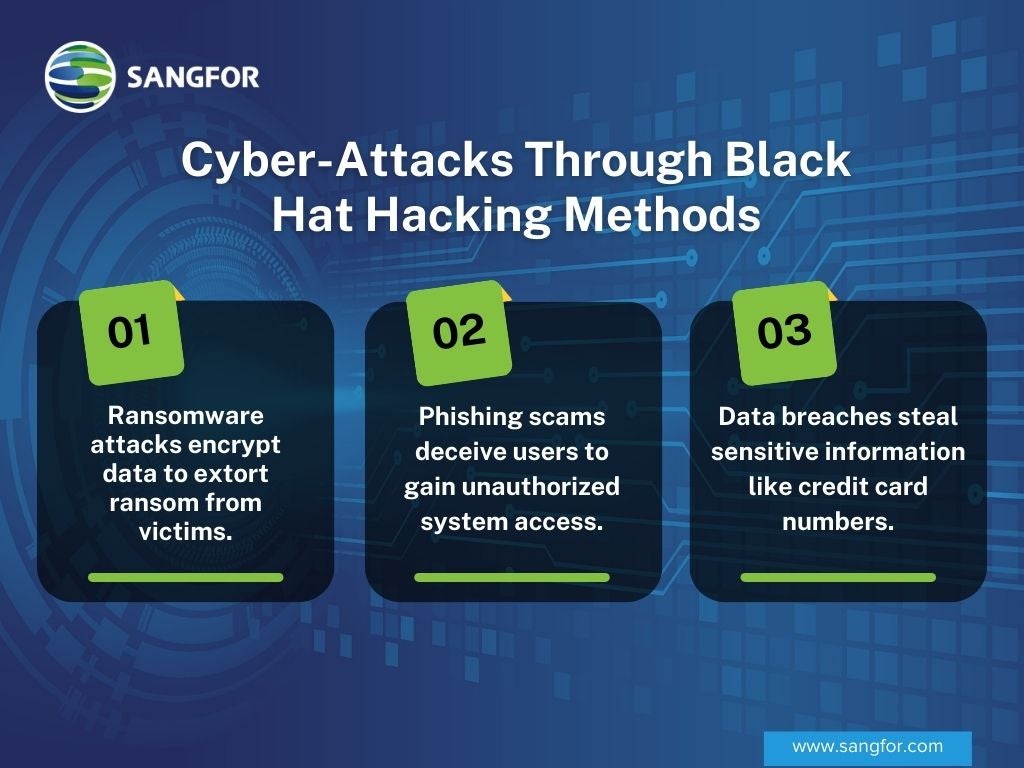Black hat hacking, also known as black hat computer hacking, refers to malicious activities by a black hat hacker who illegally intrudes into computer networks. However, not all hacking is malicious; ethical hacking, performed by white hat hackers, helps companies find vulnerabilities through penetration testing to improve their cybersecurity.
Unfortunately, not all skilled hackers use their abilities for good. This is where the term black hat hacker comes from, representing those who exploit vulnerabilities for malicious purposes rather than helping organizations strengthen their defenses.
What Is Black Hat Hacking?
Black hat hacking refers to the intrusion into an IT system for malicious reasons. These are the bad guys you imagine hacking into mainframes on TV, stealing credit card numbers or launching phishing attacks. However, in reality, their actions have serious consequences for individuals and organizations alike.
Black hat hacking makes use of ransomware, malware, and other tactics to break through a system’s defenses. The black hat hackers can then access, steal, and leverage the data found. Some of their techniques involve social engineering, botnets, DDoS attacks, phishing attacks, spyware, and more.
The data is usually sold on the dark web, used to extort a ransom, or simply destroyed. Hacking has become a global issue as technology evolved. The tools and techniques used in black hat hacking have become so sophisticated that thet are difficult to detect – let alone defend against without the help of ethical hacking practices employed by the good guys.
Who Are Black Hat Hackers and What Do They Do?

While these hackers are criminals, they are also highly skilled individuals. Black hat hackers use their knowledge and skill sets to exploit security vulnerabilities. These hackers have malicious intentions. These can range from financial gain and personal vendettas to political motivations and simply destructive chaos. These black hat hackers can work independently or within organized black hat hacking groups. There are multiple large and organized black hat hacking groups in existence already. Some of these groups offer their skills as Ransomware-as-a-Service. In contrast, gray hat hackers may exploit vulnerabilities without malicious intent but still without authorization, blurring the line between the good guys and the bad.
While these hackers have honed their skills, many of them start as “script kiddies.” These are novice hackers that use the scripts and tools of others to launch small-scale cyber-attacks. However, the younger generation is exactly where the focus is for most hackers looking to recruit. The increase in RaaS – Ransomware As A Service, less awareness of cybersecurity gives them easy access to vulnerabilities and commit a cybercrime.
Cryptocurrency Encourages Black Hat Hacking
Cryptocurrency has taken the world by storm since its arrival. The virtual currency had companies like Bitcoin, Cardano, and Ethereum creating “tokens” that could be easily traded or used online.
While the main attraction to cryptocurrency was its discreet and protected nature, it soon became a medium of choice for hackers as well. Ransomware attacks could be easily facilitated with the use of cryptocurrency as a secure and anonymous channel for ransoms and payments online.
The hype around cryptocurrency has been greatly escalated by Gen Z. A recent study showed that 94% of all cryptocurrency buyers are Gen Z or Millennials ranging from 18 to 40 years old. The connection between cyber criminals and Gen Z making use of cryptocurrency is enough to establish a direct influence on the younger generations being pushed towards scoring easy crypto cash-ins through cyber-attacks. While cryptocurrency itself cannot be blamed, it is part of the tools that enable ransomware and cyber-attacks in the modern age.
Cyber-Attacks Through Black Hat Hacking Methods
Usually the enterprise business are on the radar of black hat hackers. That’s why businesses choose cybersecurity measures to stay safe. They also recruit white hat hackers who can do certain kinds of tests that can find out existing vulnerabilities within the organizations. You can find out the differences between white hat hacking and black hat hacking in this article. Black hat hacking is used to carry out all the malicious cyber-attacks you know of. Some of the main black hat hacking methods and cyber-attacks they’ve made possible recently include:
Ransomware Attacks
These are attacks in which a company or person’s system is infiltrated by black hat hackers and data is extracted. That data is then used as leverage to force the user to pay a ransom amount. The data is either threatened with being exposed or destroyed.
According to Statista, there were 236.1 million ransomware attacks worldwide during the first half of 2022 alone. One of the biggest ransomware attacks to date is the WannaCry ransomware that exploded onto the scene in May 2017.
WannaCry infected at least 75,000 computers across 99 countries - affecting hospitals and businesses alike. The ransomware targeted computers using Microsoft Windows as an operating system and encrypted essential data then extorted payments in the form of Bitcoin for its return.
The ransomware hit around 230,000 computers globally. In 2018, the WannaCry malware also hit Taiwan Semiconductor Manufacturing – the world’s largest contract chipmaker.
Phishing Attacks
A phishing attack is any cyber-attack in which a hacker attempts to deceive the victim through the use of fraudulent emails or correspondence. While the message might look authentic, it contains links or attachments with malware inside. Once the link is clicked or the attachment is downloaded, the malware enters the system and gains access to everything inside.
In 2022, communications company Twilio was the victim of a cyber-attack that used a phishing scam to infiltrate the system. A text message baited and redirected employees toward a fake website that resembled Twilio’s real authentication site.
The site then asked for the employee credentials which gave the hackers the information to gain insider access to internal company resources and customer data. The fake URLs contained "Twilio," "Okta," and "SSO" keywords. The access compromised 93 Authy accounts and potentially exposed 1,900 accounts on the encrypted communication app Signal.
Data Breaches
A data breach is a cyber-attack that compromises the data and files of clients and companies. According to Statista, approximately 15 million data records were exposed worldwide through data breaches in 2022.
In September 2022, Capital One was given a class action settlement of US$ 190 million after a data breach in 2019 exposed the personal information of more than 100 million people, including credit card numbers, and resulted in the theft of social security numbers and bank account details. Paige Thompson, a former systems engineer at Amazon Web Services, was behind the breach. Using a self-made tool to detect misconfigured AWS accounts, she used one of those accounts to hack into the systems of more than 30 organizations - including Capital One. According to her indictment, Thompson used the access she gained to steal data while “mining” cryptocurrency with the stolen computer power through crypto-jacking.

Best Practices to Defend Against Black Hat Hacking
To safeguard your business from the threats posed by black hat hackers, consider implementing the following best practices:
- Regular Security Audits: Conduct regular security audits and penetration testing to identify and fix vulnerabilities in your systems before black hat hackers can exploit them.
- Employee Training: Educate your staff about cybersecurity threats such as phishing attacks and social engineering tactics to reduce the risk of human error.
- Advanced Security Solutions: Invest in advanced security solutions like Next Generation Firewalls, Endpoint Detection and Response (EDR), and Anti-Ransomware tools.
- Data Encryption: Encrypt sensitive data, including credit card numbers and personal information, to protect it from unauthorized access.
- Access Controls: Implement strict access controls and multi-factor authentication to ensure that only authorized personnel can access critical systems.
- Incident Response Plan: Develop and regularly update an incident response plan to minimize damage in case of a security breach.
How to Protect Businesses from Black Hat Hacking
Black hat hackers make use of various tools and techniques to gain access to your systems. The only way to protect yourself is to invest in advanced tools, including ethical hacking practices like penetration testing, and techniques of your own.
Sangfor Technologies is a world-class cybersecurity and cloud computing company that offers intensive, integrated, and intelligent platforms and products that will keep any black hat hacker at bay.
Invest in Sangfor’s impressive Anti-Ransomware prevention and state-of-the-art IT infrastructure for a secure, efficient, and targeted approach to your cybersecurity.
Sangfor’s advanced Next Generation Firewall (NGFW) can be used to identify malicious files at both the network level and endpoints. The advanced firewall is a security device designed to inspect network and application traffic for threats, secure the network environment from intrusion, and bring in security intelligence from outside the network.
Additionally, the Sangfor Cyber Command platform then monitors for malware, residual security events, and future potential compromises in your network and is coupled with an enhanced AI algorithm and threat intelligence – ensuring your data is always kept strictly protected and consistently monitored for lingering threats.
Lastly, Sangfor’s powerful Endpoint Detection and Response (EDR) solution is used to go beyond traditional antivirus and anti-malware software. Endpoint Secure provides integrated protection against malware infections and APT breaches across your entire organization's network – all with ease of management,
Watch this video to see how Sangfor Endpoint Secure can detect and recover from ransomware in just 3 seconds:
For more information on Sangfor’s cybersecurity and cloud computing solutions, visit www.sangfor.com.
Contact Us for Business Inquiry
Frequently Asked Questions (FAQ)
Black hat hackers are malicious individuals who exploit security vulnerabilities for personal gain or destructive purposes. White hat hackers, also known as ethical hackers, use their skills to identify and fix vulnerabilities through practices like penetration testing to help organizations improve their security. Gray hat hackers fall somewhere in between; they may exploit vulnerabilities without malicious intent but still without authorization, which can still be illegal.
Black hat hackers use a variety of methods to infiltrate systems, including malware, ransomware, phishing attacks, social engineering, and exploiting software vulnerabilities. They may also use advanced techniques to bypass security measures and gain unauthorized access to sensitive data like credit card numbers.
Signs of a security breach may include unexpected system slowdowns, unusual network activity, unfamiliar programs running, frequent crashes, or unexpected pop-ups. Unauthorized transactions or changes to accounts may also indicate that your system has been compromised by a black hat hacker.
Ethical hacking, performed by white hat hackers, involves intentionally probing systems for vulnerabilities through methods like penetration testing. By identifying and fixing these vulnerabilities, organizations can strengthen their defenses against attacks from black hat hackers.
Skilled hackers can be either good guys or bad guys in the cybersecurity landscape. White hat hackers use their skills to enhance security and protect data, while black hat hackers exploit their skills for malicious purposes. Leveraging the expertise of ethical hackers is crucial for organizations aiming to defend against cyber threats.
Cryptocurrency provides a secure and anonymous channel for black hat hackers to receive payments, especially in ransomware attacks. The anonymity and difficulty in tracing transactions make it an attractive medium for cybercriminals.
Individuals should practice good cybersecurity hygiene, including using strong, unique passwords, enabling two-factor authentication, being cautious of suspicious emails to avoid phishing attacks, keeping software updated, and using reputable antivirus and anti-malware solutions.
Yes, in many jurisdictions, businesses are legally required to report data breaches, especially if personal data like credit card numbers or sensitive personal information is compromised. Failure to do so can result in legal penalties and loss of customer trust.
Absolutely. Black hat hackers are engaging in illegal activities and can face severe legal consequences, including fines and imprisonment, if caught and convicted.
Employee training is critical. Many breaches occur due to human error, such as falling victim to phishing attacks. Educating employees about cybersecurity best practices can significantly reduce the risk of successful attacks by black hat hackers.





